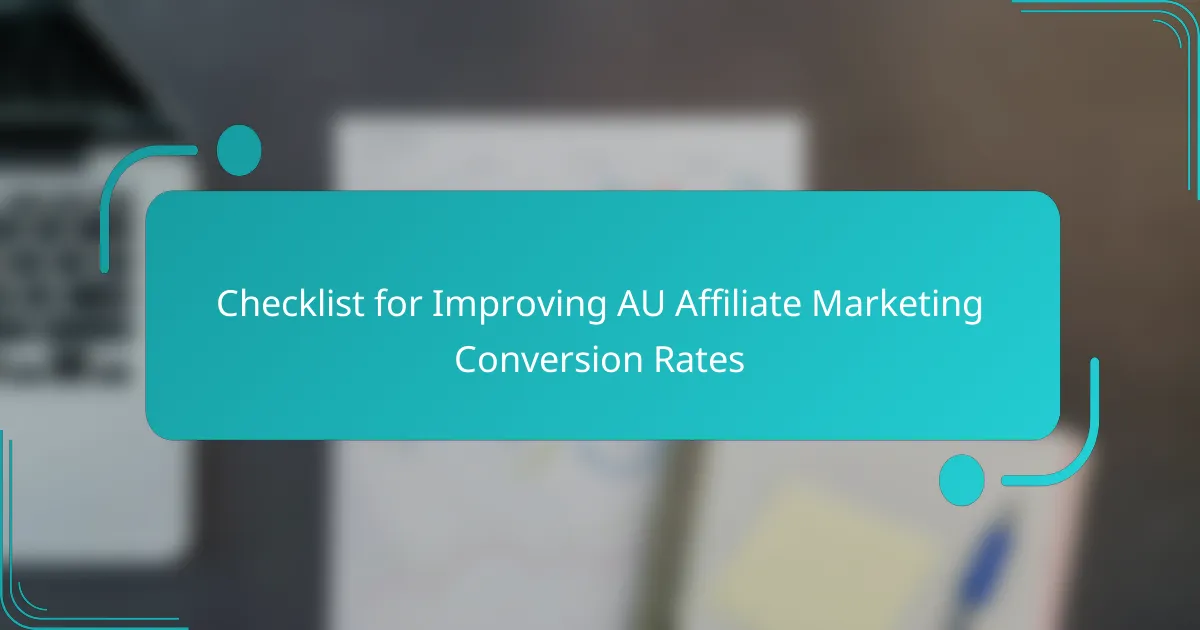Improving conversion rates in Australian affiliate marketing requires a strategic approach focused on user experience and engagement. By optimising landing pages, employing strong calls to action, and utilising targeted marketing techniques, marketers can significantly enhance their performance. Additionally, leveraging tools for conversion rate optimisation can provide valuable insights and facilitate better decision-making, ultimately leading to increased sales.

How can Australian affiliate marketers improve conversion rates?
Australian affiliate marketers can enhance conversion rates by focusing on key strategies that optimise user experience and engagement. Implementing effective landing pages, strong calls to action, and targeted marketing techniques can significantly boost performance.
Optimise landing pages
Optimising landing pages is crucial for improving conversion rates. Ensure that your landing pages are visually appealing, load quickly, and are mobile-friendly, as many users access content via smartphones. Use clear headlines and concise content that directly addresses the needs of your target audience.
Incorporate elements like testimonials, trust badges, and compelling images to build credibility. A/B testing different layouts and content can help identify what resonates best with your audience, leading to higher conversion rates.
Enhance call-to-action effectiveness
Effective calls to action (CTAs) are essential for guiding users toward desired actions. Use action-oriented language that creates a sense of urgency, such as “Get Started Now” or “Claim Your Discount Today.” Position your CTAs prominently on the page to ensure they are easily visible.
Experiment with different colours, sizes, and placements to find the most effective combination. A/B testing can reveal which CTAs drive the highest engagement and conversions, allowing for data-driven decisions.
Leverage email marketing strategies
Email marketing remains a powerful tool for affiliate marketers. Build a targeted email list by offering valuable content or incentives, such as exclusive discounts or free resources. Regularly engage with your audience through newsletters that highlight new products or promotions.
Segment your email list based on user behaviour and preferences to tailor your messages. Personalised emails can lead to higher open and click-through rates, ultimately improving conversion rates.
Utilise A/B testing
A/B testing is an effective method for optimising various elements of your marketing strategy. By comparing two versions of a webpage, email, or ad, you can determine which performs better in terms of conversions. Focus on testing one variable at a time, such as headlines, images, or CTA placements.
Track metrics like click-through rates and conversion rates to assess performance. Regularly conducting A/B tests can help refine your strategies and lead to continuous improvement in conversion rates.
Implement retargeting campaigns
Retargeting campaigns are designed to re-engage users who have previously interacted with your content but did not convert. By displaying targeted ads to these users across various platforms, you can remind them of your offerings and encourage them to return.
Utilise platforms like Google Ads and Facebook Ads to set up retargeting campaigns. Tailor your messaging based on user behaviour, such as showing specific products they viewed. This personalised approach can significantly increase the likelihood of conversions.

What tools can assist in conversion rate optimisation?
Several tools can significantly aid in conversion rate optimisation (CRO) by providing insights into user behaviour, tracking performance metrics, and facilitating testing. Utilising these tools effectively can lead to improved decision-making and higher conversion rates for affiliate marketing efforts.
Google Analytics for tracking
Google Analytics is essential for tracking website performance and user interactions. It provides detailed reports on traffic sources, user demographics, and behaviour flow, allowing marketers to identify which channels drive the most conversions.
To maximise its effectiveness, set up goals that align with your conversion objectives. Regularly review metrics such as bounce rates and conversion rates to pinpoint areas needing improvement. Consider segmenting your audience to gain deeper insights into specific user groups.
Hotjar for user behaviour insights
Hotjar offers valuable insights into user behaviour through heatmaps, session recordings, and surveys. These features help you understand how users interact with your site, revealing areas of friction that may hinder conversions.
Utilise heatmaps to visualise where users click and scroll, and analyse session recordings to observe real-time user navigation. Implementing feedback surveys can also provide direct insights into user preferences and pain points, guiding your optimisation efforts.
Optimizely for A/B testing
Optimizely is a powerful tool for A/B testing, allowing marketers to compare different versions of web pages to determine which performs better in terms of conversions. This data-driven approach helps in making informed decisions based on user responses.
When using Optimizely, focus on testing one variable at a time, such as headlines or call-to-action buttons, to isolate the impact of each change. Aim for a statistically significant sample size to ensure reliable results, and continuously iterate based on findings to enhance conversion rates over time.

What are the best practices for affiliate link placement?
Effective affiliate link placement is crucial for maximising conversion rates. By strategically positioning links within your content, you can enhance user engagement and drive more sales.
Contextual link integration
Integrating affiliate links contextually means placing them within relevant content where they naturally fit. This approach increases the likelihood that users will click on the links because they see them as part of the information they are seeking.
For example, if you are writing a review about a specific product, including an affiliate link to that product within the review can lead to higher conversions. Aim for a balance—too many links can overwhelm readers, while too few may miss opportunities.
Strategic placement within content
Strategic placement involves positioning affiliate links at key points in your content, such as near the beginning or at the end of a blog post. Placing links where readers are most engaged can significantly boost click-through rates.
Consider using a mix of placements, such as within the first few paragraphs, after a compelling section, or in a call-to-action at the end. Testing different placements can help identify what works best for your audience.
Using banners effectively
Banners can be an effective way to promote affiliate products, especially when they are visually appealing and relevant to your content. Ensure that banners are placed in high-visibility areas, such as the top of a webpage or within the sidebar.
When using banners, consider the size and design; they should complement your site’s aesthetics while clearly conveying the offer. Regularly update banners to reflect current promotions or seasonal offers, which can help maintain user interest and improve conversion rates.

How does audience segmentation impact conversions?
Audience segmentation significantly enhances conversions by allowing marketers to tailor their strategies to specific groups. By understanding the unique characteristics and preferences of different segments, businesses can create more effective marketing campaigns that resonate with their target audience.
Targeted messaging for demographics
Targeted messaging involves crafting content that speaks directly to the specific demographics of your audience, such as age, gender, location, and income level. For instance, a campaign aimed at millennials may use informal language and social media platforms, while messaging for older adults might focus on email and traditional media.
To implement targeted messaging, start by analysing your audience data to identify key demographic segments. Create tailored messages that address the unique needs and interests of each group, ensuring that your content feels relevant and engaging. Avoid generic messaging that fails to connect with any specific audience.
Personalisation based on user behaviour
Personalisation based on user behaviour involves adjusting marketing efforts according to how users interact with your content and products. This can include recommending products based on past purchases or tailoring email content based on browsing history. Such strategies can significantly boost conversion rates by making users feel understood and valued.
To effectively personalise your marketing, utilise analytics tools to track user behaviour and preferences. Implement dynamic content that changes based on user interactions, such as showing different offers to returning visitors versus new users. Remember to respect user privacy and comply with regulations like GDPR when collecting and using data.

What role does SEO play in affiliate marketing conversions?
SEO is crucial for driving organic traffic to affiliate marketing sites, which can significantly enhance conversion rates. By optimising content for search engines, affiliates can attract more visitors who are actively seeking the products or services they promote.
Keyword optimisation for traffic
Keyword optimisation involves researching and selecting relevant terms that potential customers are likely to use in search engines. Focus on long-tail keywords, as they tend to have lower competition and higher intent, leading to better conversion rates.
Utilise tools like Google Keyword Planner or SEMrush to identify keywords with decent search volume and manageable competition. Aim for a mix of high-volume and niche keywords to balance traffic and conversion potential.
On-page SEO best practices
On-page SEO refers to optimising individual web pages to rank higher and earn more relevant traffic. Key practices include using target keywords in titles, meta descriptions, headers, and throughout the content while ensuring it reads naturally.
Additionally, improve user experience by enhancing page load speed, ensuring mobile-friendliness, and using clear calls-to-action. Regularly updating content can also signal to search engines that your site is active, which can positively impact rankings.

How can social proof enhance affiliate marketing success?
Social proof can significantly boost affiliate marketing success by building trust and credibility with potential customers. When users see that others have had positive experiences with a product or service, they are more likely to make a purchase themselves.
Types of social proof to consider
There are several types of social proof that can enhance affiliate marketing efforts. Customer reviews, testimonials, and user-generated content are among the most effective. Additionally, showcasing endorsements from influencers or industry experts can further validate a product’s quality.
How to implement social proof effectively
To implement social proof effectively, ensure that reviews and testimonials are prominently displayed on your affiliate site. Use clear, relatable language and include images or videos where possible to make the content more engaging. Consider integrating real-time data, such as the number of recent purchases, to create a sense of urgency.
Common pitfalls to avoid
One common pitfall is using fake or exaggerated testimonials, which can damage credibility if discovered. Avoid overwhelming visitors with too much information; instead, curate a selection of high-quality reviews that resonate with your target audience. Lastly, ensure that the social proof is relevant to the products you are promoting, as mismatched endorsements can confuse potential buyers.
